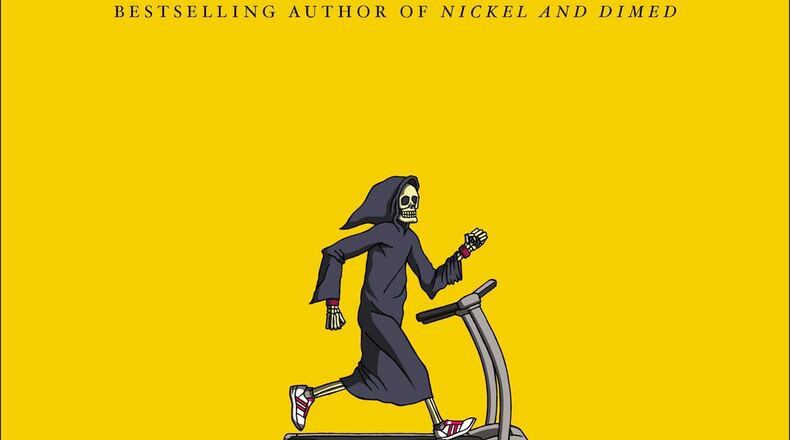In her 2001 book, “Nickel and Dimed: On (Not) Getting by in America,” journalist Barbara Ehrenreich goes undercover as an employee in several minimum-wage jobs (waitress, hotel maid, nursing home aide, etc.) to expose the reality of those earning wages so low they can’t afford to feed, shelter, clothe or meet their health care needs. The critically acclaimed book shed light on the consequences harsh economic policies have on workers barely getting by.
Ehrenreich’s latest book, “Natural Causes: An Epidemic of Wellness, the Certainty of Dying, and Killing Ourselves to Live Longer,” sounds promising enough. At the relatively healthy age of 76 (she survived breast cancer in 2000 when she was 58), Ehrenreich decides to investigate America’s obsession with living longer and healthier, and in the process, critiques the push for screenings, annual exams and scans for asymptomatic senior citizens like herself, and graciously accepts her station in life. “I gradually came to realize that I was old enough to die.”
Mortality is not a philosophical dilemma one needs to ponder endlessly, Ehrenreich assures us, and death, after several decades on earth, should not be feared or avoided. “In giving up on preventative care, I’m just taking this line of thinking a step further: Not only do I reject the torment of a medicalized death, but I refuse to accept a medicalized life, and my determination deepens with age.”
Whereas “Nickel and Dimed” focused on the plight of the poor working class, “Natural Causes,” concerns itself with the upper-crust, the top tier, those with comprehensive health care and the time, energy and money to attend myriad appointments, shell out dough for sky-rocketing deductibles and elective procedures, and enroll in weekend getaways at medical spas.
While it’s certainly the case, as Ehrenreich posits, that routine, non-emergency tests and false positives needlessly cause stress and anxiety, the kind of health care coddling she bemoans is a pipe dream for many Americans. The chapter “Death in Social Context,” touches on the well-being of the have-nots, but the passages primarily center on poor white Americans. In one section, “The Great White Die Off,” she writes, “Poor whites had always had the comfort of knowing that someone was worse off and more despised than they were; racial subjugation was the ground under their feet, the rock they stood upon, even when their own situation was deteriorating.”
The “worse off,” whether they be disabled, poor, LGBTQIA or communities of color are largely ignored in the book. It’s a missed opportunity to examine how and to what degree members of historically marginalized groups have access to full, healthy lives so that they, too, might die of natural causes.
Elsewhere in the book, it’s difficult to ascertain what, exactly, Ehrenreich is debunking.
In “The Madness of Mindfulness,” she addresses what she deems is the proliferation of “shrinking attention spans,” citing a graphic from a 2015 Microsoft Canada report that illustrates how the human attention span has shrunk from 12 seconds to 8 seconds, one second less than that of a goldfish. (The statistic itself comes from a website called Statistic Brain.)
“Small screens seemed to have swallowed the world,” she laments. The perpetrator? Silicon Valley, “the high-tech industry that created the tempting devices and social networks that consume so much of our time.”
Ehrenreich points to several factors — Steve Jobs’ “obsessive attention to details and complete withdrawal into himself,” “the unblinking, almost affect-free Bill Gates,” the personalities of the characters in HBO’s series “Silicon Valley,” and even Apple’s slogan, “Think Different” — as evidence that Silicon Valley is “ground zero of the inattentiveness epidemic.”
Given the plethora of research on the topic, her word choice and quotation usage with respect to certain neurological conditions seem odd. “Among the many diagnoses being bandied about are autism, which now occupies an entire ‘spectrum’ of symptoms, Asperger’s syndrome, attention deficit disorder (ADD), and attention deficit hyperactivity disorder (ADHD) — all of which overlap in symptomatology and can markedly affect academic performance.” On the following page, she adds: “It did not take years of laboratory research to get to the likely source of this new ‘epidemic.’”
Does Ehrenreich truly believe that small screens cause autism and diagnoses are being “bandied about”? It would certainly seem so. She fails to mention other possibilities, like the improvement of diagnostic tools over the years or the push for earlier screening. Her theories in “The Madness of Mindfulness” feel a little too much like junk science. Considering Ehrenreich’s significant scientific background (she holds a Ph.D in cellular immunology) her disregard of other possible causes is glaring.
Still, all is not lost with “Natural Causes.” Ehrenreich deftly critiques the phenomena of “successful aging,” achieved through celebrity-endorsed, reverse-aging skin-care products, and exercise, the capitalist and consumer-driven industry that encourages people to contort their bodies into unnatural positions, repeat sequences ad nausea, and fork over cash for flashy fitness centers. Her interrogation of the evolution of wellness centers, which advocate for conscientious (and expensive) measures to reconnect the mind to its seemingly disconnected body, is keen and rigorous.
Besides, none of these absurd exertions will matter when the grim reaper comes knocking. “The organs we nurtured with supplements and superfoods abandon their appointed functions. The brain we have tamed with mindfulness exercises goes awry within minutes after the heart stops beating.” No matter, muses Ehrenreich, for a death at the end of a bountiful life is a kind of victory in and of itself. “Being old enough to die is an achievement, not a defeat, and the freedom it brings is worth celebrating.”
NONFICTION
‘Natural Causes’
By Barbara Ehrenreich
Hachette
256 pages, $27
About the Author
Keep Reading
The Latest
Featured


